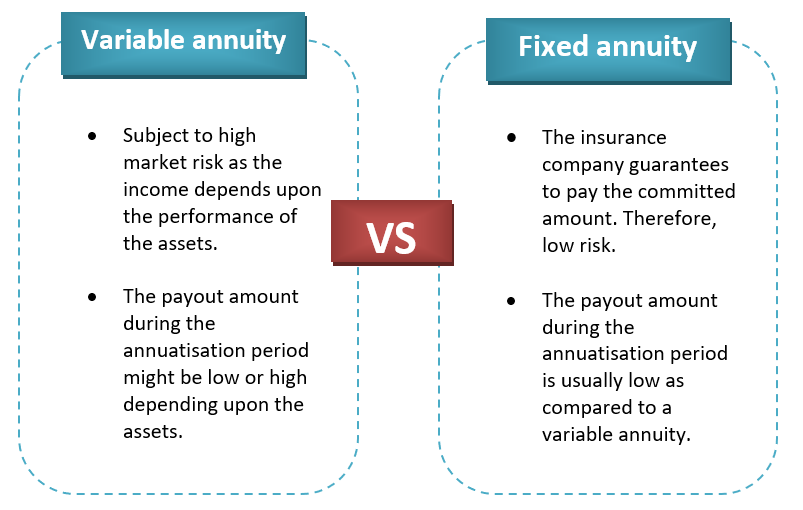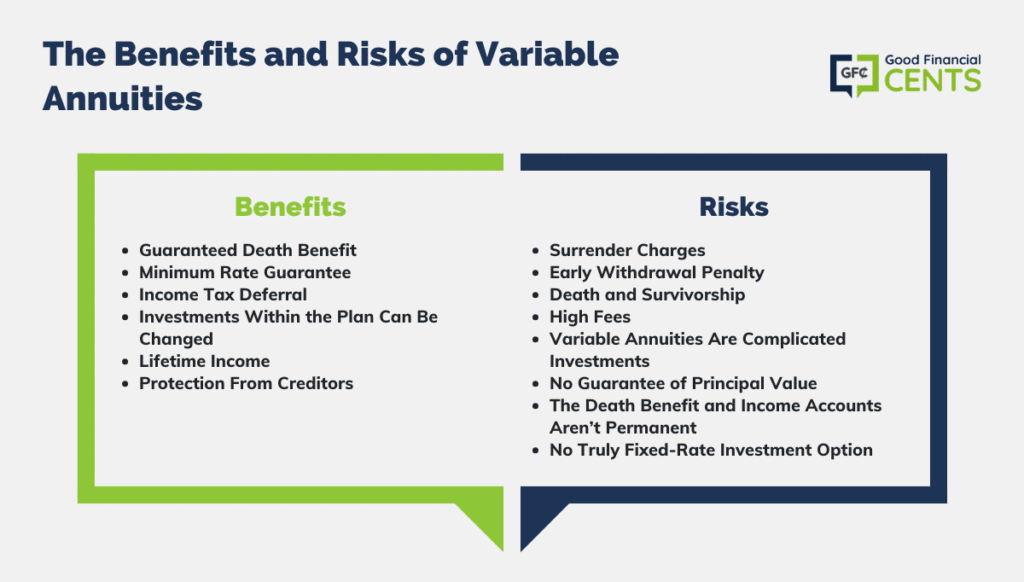All Categories
Featured
Table of Contents
Equally as with a fixed annuity, the proprietor of a variable annuity pays an insurance provider a lump amount or series of payments for the assurance of a series of future settlements in return. As pointed out above, while a fixed annuity expands at an assured, constant rate, a variable annuity expands at a variable rate that depends upon the performance of the underlying financial investments, called sub-accounts.

During the accumulation stage, assets purchased variable annuity sub-accounts grow on a tax-deferred basis and are tired only when the contract owner withdraws those incomes from the account. After the accumulation stage comes the revenue phase. In time, variable annuity assets ought to in theory enhance in value until the agreement proprietor determines she or he would certainly like to start withdrawing cash from the account.
The most substantial problem that variable annuities typically existing is high expense. Variable annuities have numerous layers of charges and expenditures that can, in accumulation, produce a drag of up to 3-4% of the contract's value each year.
Analyzing Strategic Retirement Planning A Comprehensive Guide to Investment Choices Breaking Down the Basics of Investment Plans Benefits of Variable Vs Fixed Annuities Why What Is Variable Annuity Vs Fixed Annuity Matters for Retirement Planning Fixed Vs Variable Annuity Pros And Cons: How It Works Key Differences Between Fixed Index Annuity Vs Variable Annuity Understanding the Risks of What Is Variable Annuity Vs Fixed Annuity Who Should Consider Variable Vs Fixed Annuity? Tips for Choosing the Best Investment Strategy FAQs About Planning Your Financial Future Common Mistakes to Avoid When Choosing a Financial Strategy Financial Planning Simplified: Understanding Your Options A Beginner’s Guide to Deferred Annuity Vs Variable Annuity A Closer Look at How to Build a Retirement Plan
M&E expense charges are determined as a portion of the contract value Annuity providers pass on recordkeeping and various other management expenses to the contract owner. This can be in the form of a level annual cost or a percent of the contract worth. Administrative charges might be included as part of the M&E risk cost or may be examined independently.
These costs can range from 0.1% for easy funds to 1.5% or more for proactively managed funds. Annuity agreements can be personalized in a number of methods to offer the certain needs of the contract owner. Some typical variable annuity cyclists include ensured minimum accumulation advantage (GMAB), ensured minimum withdrawal benefit (GMWB), and ensured minimum earnings benefit (GMIB).

Variable annuity payments provide no such tax reduction. Variable annuities have a tendency to be extremely ineffective vehicles for passing riches to the next generation because they do not enjoy a cost-basis modification when the original contract owner dies. When the owner of a taxable financial investment account passes away, the price bases of the financial investments held in the account are adapted to mirror the market costs of those investments at the time of the owner's fatality.
Decoding How Investment Plans Work A Closer Look at Fixed Annuity Vs Variable Annuity What Is Fixed Interest Annuity Vs Variable Investment Annuity? Advantages and Disadvantages of Fixed Annuity Vs Equity-linked Variable Annuity Why Choosing the Right Financial Strategy Is a Smart Choice How to Compare Different Investment Plans: Simplified Key Differences Between Immediate Fixed Annuity Vs Variable Annuity Understanding the Rewards of Fixed Annuity Vs Variable Annuity Who Should Consider Strategic Financial Planning? Tips for Choosing Fixed Index Annuity Vs Variable Annuity FAQs About Planning Your Financial Future Common Mistakes to Avoid When Choosing a Financial Strategy Financial Planning Simplified: Understanding Fixed Income Annuity Vs Variable Annuity A Beginner’s Guide to Annuity Fixed Vs Variable A Closer Look at Fixed Vs Variable Annuity
Such is not the instance with variable annuities. Investments held within a variable annuity do not obtain a cost-basis modification when the original owner of the annuity dies.
One substantial concern associated to variable annuities is the possibility for problems of rate of interest that might feed on the part of annuity salespeople. Unlike a financial consultant, who has a fiduciary obligation to make financial investment decisions that benefit the customer, an insurance policy broker has no such fiduciary responsibility. Annuity sales are extremely rewarding for the insurance coverage experts that offer them as a result of high upfront sales commissions.

Many variable annuity agreements consist of language which positions a cap on the percentage of gain that can be experienced by specific sub-accounts. These caps stop the annuity proprietor from fully taking part in a part of gains that can or else be enjoyed in years in which markets produce significant returns. From an outsider's point of view, presumably that capitalists are trading a cap on financial investment returns for the abovementioned ensured floor on investment returns.
As noted over, surrender fees can significantly restrict an annuity proprietor's ability to relocate possessions out of an annuity in the very early years of the contract. Further, while a lot of variable annuities permit contract proprietors to take out a specified quantity during the buildup phase, withdrawals past this amount commonly cause a company-imposed charge.
Withdrawals made from a set rate of interest price investment choice can also experience a "market price adjustment" or MVA. An MVA adjusts the value of the withdrawal to show any changes in rate of interest from the time that the cash was bought the fixed-rate alternative to the time that it was withdrawn.

Frequently, also the salespeople that market them do not completely comprehend how they work, therefore salespeople in some cases victimize a purchaser's emotions to market variable annuities as opposed to the values and suitability of the items themselves. Our team believe that investors should fully recognize what they possess and how much they are paying to possess it.
Highlighting the Key Features of Long-Term Investments A Comprehensive Guide to Retirement Income Fixed Vs Variable Annuity Breaking Down the Basics of Investment Plans Benefits of Choosing the Right Financial Plan Why Choosing the Right Financial Strategy Is a Smart Choice How to Compare Different Investment Plans: Explained in Detail Key Differences Between Choosing Between Fixed Annuity And Variable Annuity Understanding the Key Features of Variable Vs Fixed Annuity Who Should Consider Strategic Financial Planning? Tips for Choosing the Best Investment Strategy FAQs About Planning Your Financial Future Common Mistakes to Avoid When Choosing Fixed Indexed Annuity Vs Market-variable Annuity Financial Planning Simplified: Understanding Fixed Indexed Annuity Vs Market-variable Annuity A Beginner’s Guide to Variable Annuity Vs Fixed Annuity A Closer Look at Fixed Annuity Vs Equity-linked Variable Annuity
The very same can not be stated for variable annuity assets held in fixed-rate financial investments. These properties legally belong to the insurance coverage company and would certainly for that reason be at risk if the company were to fall short. Likewise, any type of assurances that the insurance provider has accepted give, such as an assured minimal earnings benefit, would remain in question in the occasion of a business failure.
Possible buyers of variable annuities must comprehend and consider the monetary problem of the releasing insurance coverage business before getting in into an annuity agreement. While the benefits and disadvantages of various kinds of annuities can be debated, the real problem surrounding annuities is that of suitability.
As the stating goes: "Buyer beware!" This post is prepared by Pekin Hardy Strauss, Inc. Fixed annuity contracts. ("Pekin Hardy," dba Pekin Hardy Strauss Riches Management) for informative functions only and is not meant as a deal or solicitation for organization. The info and data in this short article does not constitute lawful, tax, audit, investment, or various other expert guidance
Table of Contents
Latest Posts
Understanding Fixed Vs Variable Annuity Pros And Cons A Closer Look at Tax Benefits Of Fixed Vs Variable Annuities Defining Fixed Vs Variable Annuity Pros Cons Advantages and Disadvantages of Immediat
Breaking Down Immediate Fixed Annuity Vs Variable Annuity Key Insights on Tax Benefits Of Fixed Vs Variable Annuities Defining the Right Financial Strategy Benefits of Choosing the Right Financial Pla
Exploring the Basics of Retirement Options Everything You Need to Know About Financial Strategies What Is Fixed Index Annuity Vs Variable Annuities? Benefits of Fixed Vs Variable Annuity Pros Cons Why
More
Latest Posts